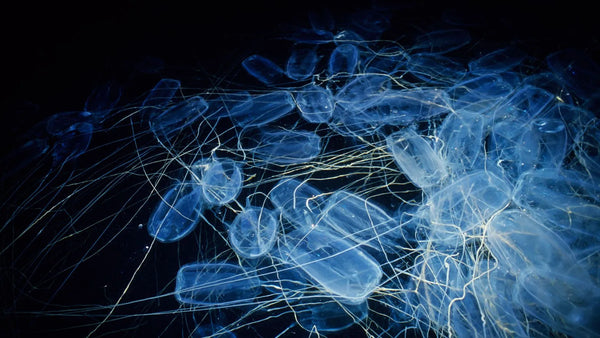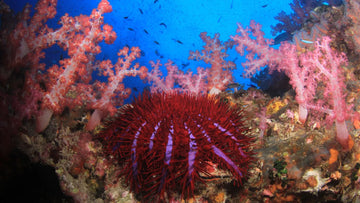The ocean is beautiful, but it can also be dangerous. Discover five amazing creatures that captivate with their splendor, yet command respect with their potent poison. From the mysterious box jellyfish to the elusive striped surgeonfish, the nearly invisible stonefish, the fascinating blue-ringed octopus, and the dreaded crown-of-thorns starfish.
Before continuing with the post, we have the perfect gift for any ocean lover—check out our collection of t-shirts for ocean enthusiasts. Organic cotton and designs inspired by ocean biodiversity. We also have sea-themed posters and decorative prints!
Dive with us into this fascinating underwater world where beauty and danger intertwine in surprising ways! 🌊🐠🌟
Striped surgeonfish (Acanthurus lineatus)

Striped surgeonfish
Crown-of-thorns starfish (Acanthaster plancis)

This starfish, the only known venomous starfish of the 1,800 species, is one of the most spectacular in the echinoderm world. This bright reddish-orange and purple starfish with yellow and pink barbs warns its predators of its high toxicity. It has up to 20 arms and can grow up to 60 cm in diameter.

It is found in the warm waters of the Pacific & Indian Ocean and Red Sea, where it feeds on delicate coral polyps. The spines of this starfish are hard and full of venom that, when stuck and released, cause an intense stinging pain that lasts for several days.
Stonefish (Synanceia horridaa)

Stonefish in Maldivian waters. Image by Philippe Guillaume
The stonefish is the most poisonous fish in the world, with venom as powerful as that of the cobra and capable of killing a human. It has powerful neurotoxins that it secretes through 13 needles located in its spine that it raises when it feels threatened. Their name comes from the fact that it is very difficult to distinguish them from rocks, as they have a perfect camouflage of a mottled gray color. This makes them even more dangerous as they can live on the shore for 24 hours at low tide and can be stepped on if mistaken for a rock. The sting is said to be so painful that some victims request that the affected limb, usually the feet, be amputated to ease the pain. Its venom has an antidote, but can be fatal if not administered within a few hours, and is the second most commonly used antidote in Australia, where it lives.
Box jellyfish (Chironex fleckeri)

The box jellyfish, also known as the wasp jellyfish, is a jellyfish that lives off the coast of Australia and is capable of killing a person by contact with its tentacles. It is the most poisonous jellyfish on the planet.
The rubbing of its tentacles on the victim usually goes unnoticed and leaves no immediate visible injuries, but after 20 minutes an intense pain is felt throughout the body. The tentacles are made up of millions of darts that, when inserted into the skin, shoot the toxin into the victim's bloodstream. At that moment, the heart rate accelerates and the blood pressure rises, leading to a cardiac embolism and death.
Although there is no official data, it is believed that dozens of people die from box jellyfish stings every year. In the Philippines alone, between 20 and 40 people die each year from box jellyfish stings, according to the National Science Foundation.
Blue-ringed octopus (Hapalochlaena genus)

The blue-ringed octopus is the most venomous creature known in the ocean and has few rivals on land. It is a 28 gram creature with enough venom to kill 26 adults.
Found off the coasts of Japan, Indonesia, Malaysia, the Philippines and Australia (by now the reader will have noticed the fixation of the most dangerous animals in the ocean on Australia), it should not be approached when its blue rings turn an intense color and the brown center of the rings becomes darker and darker. This is a sign that it is on the defensive and you should be wary of a bite from it as it will most certainly result in death.





















